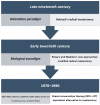Breast Cancer Surgery: New Issues
- PMID: 34677262
- PMCID: PMC8534635
- DOI: 10.3390/curroncol28050344
Breast Cancer Surgery: New Issues
Abstract
Since ancient times, breast cancer treatment has crucially relied on surgeons and clinicians making great efforts to find increasingly conservative approaches to cure the tumor. In the Halstedian era (mid-late 19th century), the predominant practice consisted of the radical and disfiguring removal of the breast, much to the detriment of women's psycho-physical well-being. Thanks to enlightened scientists such as Professor Umberto Veronesi, breast cancer surgery has since impressively progressed and adopted a much more conservative approach. Over the last three decades, a better understanding of tumor biology and of its significant biomarkers has made the assessment of genetic and molecular profiles increasingly important. At the same time, neo-adjuvant treatments have been introduced, and great improvements in genetics, imaging technologies and in both oncological and reconstructive surgical techniques have been made. The future of breast cancer management must now rest on an ever more precise and targeted type of surgery that, through an increasingly multidisciplinary and personalized approach, can ensure oncological radicality while offering the best possible quality of life.
Keywords: breast cancer; breast cancer surgery; breast conservative surgery; hereditary breast cancer; margin; neo-adjuvant chemotherapy; nipple sparing mastectomy.
Conflict of interest statement
The authors declare no conflict of interest.
Figures
References
-
- Bell B. A System of Surgery. Charles Elliot; Edinburgh, UK: 1783.



